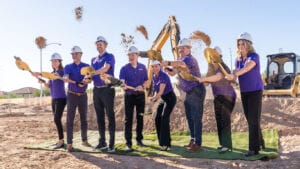Steve Jobs once said, “Innovation distinguishes between a leader and a follower.”
Arizona State University has emerged as a leader in research and innovation — U.S. News and World Report has ranked ASU as the most innovative university in the nation for five straight years. More recently, SkyBridge’s under-construction air cargo customs facility and the Phoenix-Mesa Gateway Airport corridor — chock-full of aerospace, technology, and advanced manufacturing — has helped the East Valley emerge as a leader in innovation.
So what happens when multiple forces of East Valley innovation collide? They create the ASU Polytechnic Campus Innovation Zone.
Situated moments from Phoenix-Mesa Gateway Airport and SkyBridge, the United States’ only inland international air logistics and joint U.S.-Mexico Customs processing hub, the Innovation Zone is designed to meet the needs for businesses’ tech-transfer, advanced solutions, transportation and logistics needs.
On paper, the Innovation Zone has the potential to become a hub of innovation. Here are other advantages of being in the zone:
• It’s the future home of the ASU Polytechnic Research Park that will specialize in hands-on exploration of innovative solutions in aviation, alternate energy, human-technology integration, comprehensive commercial printing and design services, and on-demand digital manufacturing.
• The Polytechnic campus is home to the Polytechnic School, one of the six schools comprising ASU’s Ira A. Fulton Schools of Engineering, the largest engineering school in the country, so tech companies have access to a sizable presence of engineering students who are being trained at the largest engineering school in the nation.
• There is access to advanced research — from expandable drones and flexible robotics to metal 3D printing.
There is access to the Fiber Optic Telecommunications Network as many areas of the Mesa-Gateway area provide redundant lit and dark telecom fiber.
• The zone is adjacent to the Phoenix-Mesa Gateway Airport and proximate to the Eastmark mixed-use development.
Of course, the bigger picture of this partnership is more complex. The Innovation Zone project has the potential to help turn the entire state of Arizona into the premier hotspot for technology, aerospace, and engineering startups and existing industry front-runners. Perhaps even more exciting is the potential to attract and foster businesses still in their innovative gestation.
And beyond innovation, there’s that bit about prolific business growth, thriving employment opportunities and a robust economic impact.
Now is the time. The East Valley is the destination. Phoenix-Mesa Gateway is the place. All innovators are invited.
The fellowship of the thought leaders
In J. R. R. Tolkien’s “Lord of the Rings,” it took a fellowship of brave, dynamic thinkers to accomplish a fantastic feat. While the Innovation Zone project doesn’t come with quite the same degree of risk (as a firey eye-ball demon in the sky), it’s still an undertaking that requires collective tenacity and forward-thinking.
“ASU is a comprehensive public research university, advancing research and discovery of public value; and assuming fundamental responsibility for the economic, social, cultural and overall health of the communities it serves,” says Duane Roen, vice provost for ASU’s Polytechnic campus and dean of the College of Integrative Sciences and Arts. “We see the Polytechnic Campus’ Innovation Zone and Research Park as a key site for driving innovation and economic development in the East Valley and beyond.”
“ASU has been a long-time partner of Phoenix-Mesa Gateway,” adds J. Brian O’Neill, executive director and CEO of the Phoenix-Mesa Gateway Airport Authority. “We’ve worked on several projects together in the past. Strengthening that relationship will not only benefit ASU and Phoenix-Mesa Gateway, but it will also benefit the economy of the entire East Valley.”
In addition to the collaborative efforts of ASU Polytechnic and Phoenix-Mesa Gateway Airport, ASU is working closely with East Valley Partnership, East Valley city leaders, East Valley chambers of commerce and other organizations and institutions to fuel economic development, according to Roen.
Imitation is the sincerest form of flattery
Naturally, as the Innovation Zone and Research Park gain traction, many will compare it with the ASU Research Park in Tempe. Both those involved with Tempe’s ASU Research Park and those proponents of Mesa-Gateway’s Innovation Zone see the comparison and similarity on the models as purely positive.
“The ASU Research Park in Tempe and SkySong and the ASU-Scottsdale Innovation Center are two strong examples of our capacity to bring innovation, entrepreneurship and corporate partnerships together to yield broad and enduring benefits,” says Michael Crow, president of ASU. “ASU’s Innovation Zones focus equally on bringing value, opportunity and economic well-being to the communities we serve.”
Logistically, the total square footage of buildings on the Tempe Campus comprises 2.216 million square feet across 26 buildings.
The Mesa-Gateway Innovation Zone has 300 acres of developable land on the ASU Polytechnic campus’ south side; and several more acres, according to O’Neill, on the land adjacent to Mesa-Gateway Airport.
When Heidi Kimball, senior vice president of Sunbelt Holdings first became involved with the ASU Research Park in Tempe in 1992, there were four tenants.
“Now, we have two parcels left to lease,” Kimball says. “One is 5.5 acres, the other is 16.5 acres and is the premier centerpiece in the Park.”
In terms of economic yield, an economic impact study released by the L. William Seidman Research Institute at the W. P. Carey School of Business in 2016 revealed that ASU Research Park tenants — at the time — generated 16,160 jobs for Arizona residents, provided labor income of $865 million for Arizona workers, and was responsible for $1.418 billion of the total income generated in the state.
“ASU Research Park operations provides funding of approximately $3.5 million to ASU,” Kimball adds, “and that will increase to nearly $5 million after 2021.”
With the ASU Research Park in Tempe taking more than three decades to gain critical mass since its groundbreaking in 1984, can we expect the same timeline in terms of build-out, leasing, and economic success in the East Valley?
“It will take a little bit of time to thoughtfully plan as far as what businesses will go in,” explains Mike Hutchinson, vice president of East Valley Partnership. “But, master-planning has been taking place over the past couple years, closely examining what the infrastructure needs — for adding water, wastewater and road improvements. It’s vacant land today but it’s got great potential.”
Coming into its own
For all the similarities between the ASU Research Park in Tempe and the ASU Polytechnic Campus Innovation Zone, it’s important to remember that the Polytechnic Campus project will have its own clear distinctions.
“A key difference between the Tempe site and Polytechnic site is the latter’s close proximity (a five-minute walk) to the assets offered by ASU’s Polytechnic campus,” Roen says.
These advantages include the availability of 100 academic programs, with more than 5,000 students who study on campus, and thousands more who are enrolled in online programs offered by Polytechnic faculty. This includes the five colleges: Fulton Schools of Engineering, College of Integrative Sciences and Arts, W.P. Carey School of Business, Mary Lou Fulton Teachers College, and the School of Sustainability.
Another important difference: There are new and exciting companies, businesses, industries and innovation taking place now, that didn’t exist in 1984.
“Tenants will be companies whose work aligns with that being done at the campus, such as robotics, agribusiness and advanced manufacturing,” Crow says. “Although this zone will become a nexus of forward-thinking companies that use the latest technology to generate output that will shape our future, it will also recognize our past and sense of place through areas set aside to preserve the campus’ military history and honor Native American culture.”
Of course, the area near the Polytechnic campus is well underway as a growth magnet of economic expansion. The same goes for serving as a technology and innovation hotspot. For example, Apple recently opened a 1.3 million-square-foot global command center on Elliot Road, northeast of the campus.
On Ray Road, northeast of the campus, a host of manufacturing companies have launched their operations. West of the campus, Verde at Cooley Station recently broke ground, Roen says.
Phoenix-Mesa Gateway Airport, on the east side of the Polytechnic campus, is a hub of economic activity, serving about 1.5 million passengers last year and more projected for this year. Not to mention three 10,000-foot runways, according to O’Neill.
“Think about emerging technology companies that operate unmanned aircraft,” O’Neill says. “A business in this situation could certainly benefit from the Phoenix-Mesa Gateway and ASU partnership. There’s a lot of developable land in the East Valley, but when you consider our land and ASU’s land, it becomes a unique selling proposition. We are both looking to develop that land to its highest and best use.”
All in alignment
One thing for which all thought leaders agree when shaping the future of the Innovation Zone, is remaining highly strategic.
“The benefit is that we’re not putting all our eggs in one basket,” O’Neill says. “We are pursuing many different segments of the aviation industry, as well as other industries, because there’s a natural fit. ASU is doing the same. Together, we are committed to finding these niche opportunities to provide a solution that will be unique to certain industries and markets.”
“Successful corporations need a combination of top talent, cutting-edge innovation, economic opportunity and a high quality of life to help their operations thrive,” Crow says. “The ASU Polytechnic Innovation Zone integrates all of these facets into a single, fast-growing location capable of attracting 21st-century businesses interested in new solutions.”
And, to sum it up, Crow states it perfectly: “We have the people, the ideas and the experience to draw employers to these zones.”



